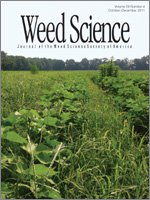Greenhouse studies were conducted to determine the relative salinity tolerance of foxtail barley and seven desirable pasture grasses. Grass species were reed canarygrass, timothy, altai wildrye, tall fescue, tall wheatgrass, orchardgrass, creeping meadow foxtail, and foxtail barley. Grasses were exposed to increasing electrical conductivity levels of NaCl and CaCl2 salt solution over time. Grass species were compared using a cumulative value of salt exposure (ECdays), which was calculated to account for the electrical conductivity (EC) and the time a plant was exposed at that level of conductivity. Salinity tolerance varied among grass species. Increasing EC significantly reduced plant biomass of all species. All grass species experienced a 50% biomass reduction (GR50) between 271 and 512 ECdays in 2008 and between 297 and 575 ECdays in 2009. Foxtail barley was among the most salt tolerant (GR50 = 512 and 525 ECdays), requiring the highest salt exposure in 2008 and the second-highest exposure in 2009 to reduce biomass 50%. Grass mortality increased with increasing EC levels. Reed canarygrass and timothy were most susceptible to increasing salinity, with 50% mortality (LD50) of both grass species occurring between 983 and 1,186 ECdays. Moderate salinity tolerance was exhibited by orchardgrass, which required 1,977 and 1,844 ECdays; creeping foxtail, which required 1,998 and 2,431 ECdays; and tall fescue, which required 2,501 and > 2,840 ECdays to LD50 in 2008 and 2009, respectively. Foxtail barley, altai wildrye, and tall wheatgrass were most tolerant of salinity and persisted with little mortality occurring at 3,033 and 2,840 ECdays in 2008 and 2009, respectively. All grass species with higher growth rates than foxtail barley and altai wildrye were more susceptible to salinity, with the exception of tall wheatgrass. Growth rates of foxtail barley and altai wildrye were less than they were for other grasses, suggesting that slower growth rates may aid in salinity tolerance.
Nomenclature: Altai wildrye, Leymus angustus AP/PR (Trin.) Pilg. ‘Mustang’; creeping meadow foxtail, Alopecurus arundinaceus Poir. ‘Garrison’; foxtail barley, Hordeum jubatum L. HORJU; orchardgrass, Dactylis glomerata L. ‘Potomac’; reed canarygrass, Phalaris arundinacea L. ‘Palaton’; tall fescue, Lolium arundinaceum (Schreb.) S.J. Darbyshire ‘Fawn’; tall wheatgrass, Thinopyrum ponticum (Podp.) Z.-W. Liu & R.-C. Wang ‘Alkar’; timothy, Phleum pratense L. ‘Climax’.





